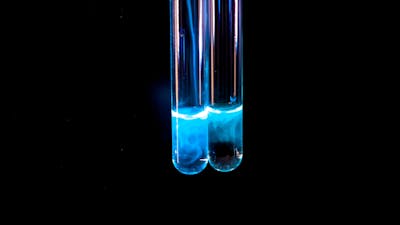- Instant analysis of tumor margins for better cancer surgery outcomes
- High-throughput, multiplexed protein detection assays at high speed and low cost
- Direct detection of small molecule targets that are too small for standard assay techniques

Sparkle: Instant Biosensors for Real-Time Imaging
Revolutionizing the binder assay industry by harnessing novel chemistry to create instant fluorescent biosensors for a wide variety of uses
Want to learn more about Sparkle?
The team is currently seeking interested partners, investors, and collaborators to continue to de-risk its technology and ultimately launch a startup.
Synthetic Biology, Living Cellular Devices
Want to learn more about Sparkle?
The team is currently seeking interested partners, investors, and collaborators to continue to de-risk its technology and ultimately launch a startup.
The Problem
While science has made great advances in developing methods to identify biomolecules from small samples, these techniques are currently expensive, time-consuming, and don’t work for all molecules of interest. These problems are limiting the performance of existing technologies and slowing the pace of scientific innovation to create new solutions in the future.
Our Solution

Sparkle is addressing this multifaceted challenge through the creation of novel small, fluorogenic protein binders that rapidly light up only when they bind directly their target molecules. Through innovation in synthetic chemistry and synthetic biology, these binders do not require any wash steps or lengthy incubation periods, can bind directly to targets that are currently too small or difficult to detect, and enable entirely new assay formats.
Product Journey
Wyss Institute members Erkin Kuru and Issac Han met while working in George Church’s lab. Kuru has deep expertise in developing non-standard amino acids, some of which fluoresce, by in vitro synthesis and he and Han realized that the technology had commercial potential. Han reached out to his colleague Helena de Puig from Jim Collins’ lab, as he knew her background in developing diagnostic devices could prove useful for the project. Together, they formed the Sparkle team and started to explore commercialization opportunities for their technology.
The fluorogenic amino acids (fgAAs) on which their technology is based were inspired by the naturally occurring green fluorescent protein (GFP), which is commonly used in scientific research. The chromophore, or portion of GFP responsible for its fluorescence, only lights up when it is physically locked in place by other portions of the protein. The Sparkle team realized that they could synthesize new classes of fgAAs that would similarly only fluoresce when “sandwiched” between their attached binder and their biomolecule target.
This method offered the potential to directly measure the presence of target molecules without lengthy, multi-step protocols. The team started synthesizing and screening different fgAAs to determine what kinds of binders they could be attached to. To date, they have a 100% success rate in designing fgAAs for specific targets of interest, including difficult-to-bind biomolecules like cortisol. When the COVID-19 pandemic hit, they pivoted their work to SARS-CoV-2 and demonstrated that Sparkle-based sensors could detect the presence of the Spike protein antigen from a sample within 0.5 seconds.
Impact

Based on its potential to dramatically speed up innovation in a wide variety of areas, Sparkle was named a Wyss Institute Validation Project in 2021 and 2022. Also in 2022, the team won the $10K Audience Choice award at the MIT $100K Entrepreneurship Competition, and was a semifinalist in the Nucleate Bio Accelerator program.
The Sparkle team is investigating multiple potential applications for its instant biosensors, including instant analysis of tumor margins for better cancer surgery outcomes, rapid high-throughput protein binding assays, and direct detection of small molecule targets that can currently only be measured by multistep competitive ELISA assays.
Want to learn more about Sparkle?
The team is currently seeking interested partners, investors, and collaborators to continue to de-risk its technology and ultimately launch a startup.